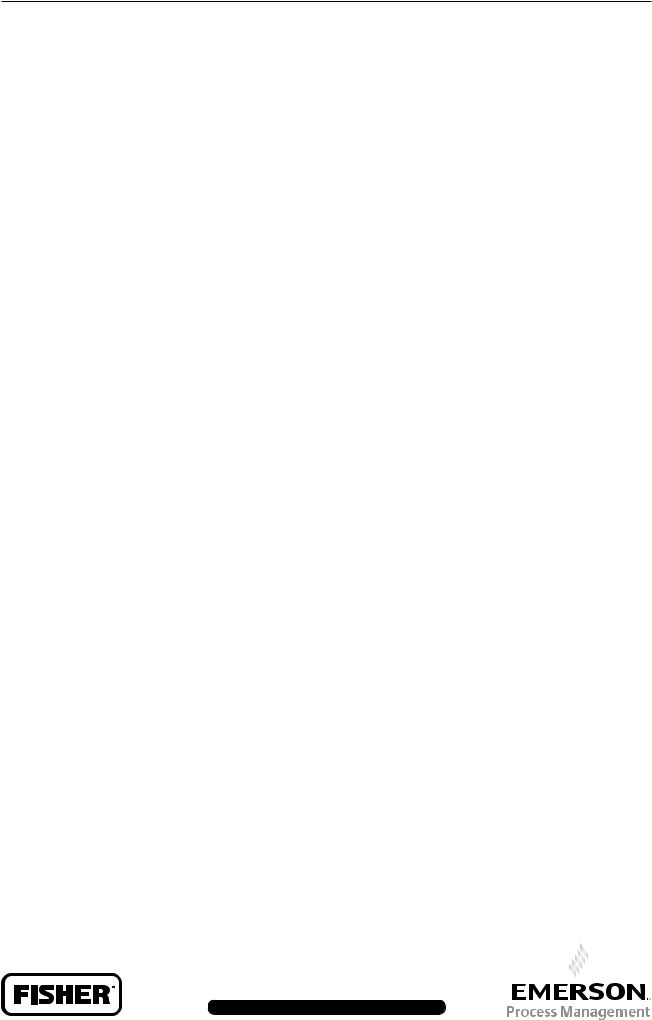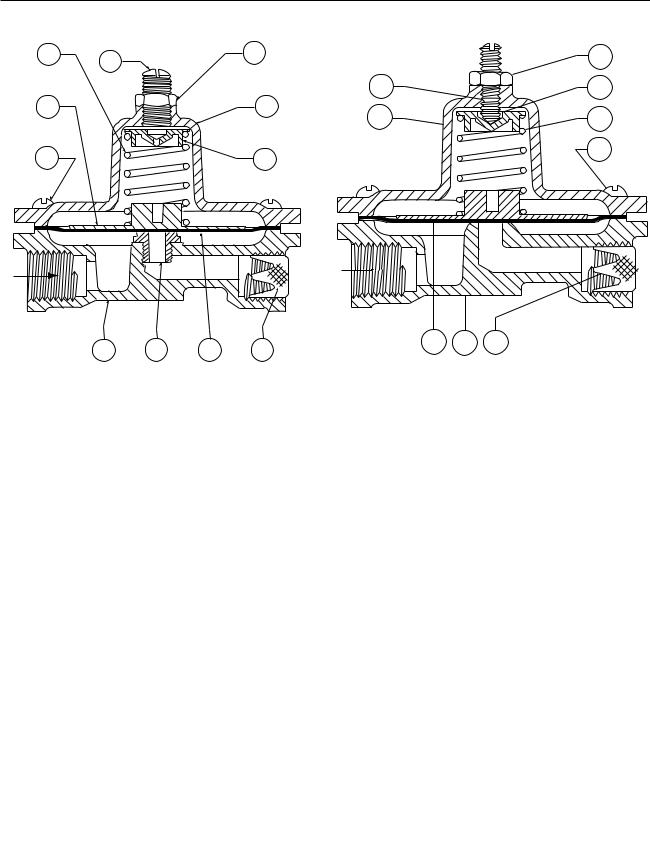Emerson 289 Installation Guide

Installation Guide |
289 Series |
English – September 2009 |
Introduction
This installation guide provides instructions for installation, startup, and adjustment. To receive a copy of the instruction manual, contact yourlocalSalesOfficeorviewacopyatwww.emersonprocess.com/ regulators. For further information refer to: 289 Series Instruction Manual (form 1724, D100280X012).
P.E.D. Category
This product may be used as a pressure accessory with pressure equipment in the following Pressure Equipment Directive 97/23/EC categories. It may also be used outside of the Pressure Equipment Directive using sound engineering practice (SEP) per table below.
product size |
categories |
fluid type |
|
Types 289A, 289U, 289L, |
SEP |
|
|
289HH, and 289H - 1 NPT |
1 |
||
|
|||
Type 289H - 2 NPT |
I |
|
|
|
|
|
Specifications
Available Configurations
Types 289A, 289H, 289HH, 289L, 289U
Body Sizes and End Connection Styles
Types 289A and 289U: 1/4 NPT Type 289H: 1 or 2 NPT
Type 289HH: 1 NPT Type 289L: 3/4 or 1 NPT
Maximum Allowable Inlet Pressure(1)(2)
Type 289A: 3,1 bar (45 psig)
Type 289H (1 NPT): 6,9 bar (100 psig)
Type 289H 2 NPT: 1,7 bar (25 psig)
Type 289HH: 6,9 bar (100 psig) Type 289L: 0,48 bar (7 psig) Type 289U: 0,69 bar (10 psig)
Proof Test Pressure
All Pressure Retaining Components have been proof tested per Directive 97/23/EC - Annex 1, Section 7.4
Spring Range (Pressure Settings)(1)
Type 289A: 0,20 to 0,90 bar (3 to 13 psig), 0,76 to 1,5 bar (11 to 22 psig)
Type 289H (DN 25 (NPS 1)): 69 to 310 mbar (1 to 4.5 psig), 0,28 to 1,03 bar (4 to 15 psig), 0,69 to 1,4 bar (10 to 20 psig), 1,03 to 3,4 bar (15 to 50 psig)
Type 289H (DN 50 (NPS 2)): 17 to 45 mbar (7 to 18-inches w.c.), 35 to 155 mbar (0.5 to 2.25 psig),
21 to 483 mbar (1.75 to 7 psig), 0,28 to 0,69 bar (4 to 10 psig)
Type 289HH: 3,1 to 5,2 bar (45 to 75 psig) Type 289L: 7 to 20 mbar (3 to 8-inches w.c.), 12 to 45 mbar (5 to 18-inches w.c.),
25 to 45 mbar (10 to 18-inches w.c.), 30 to 100 mbar (12 to 40-inches w.c.)
Type 289U: 12 to 62 mbar (5 to 25-inches w.c.), 50 to 206 mbar (20-inches w.c. to 3 psig)
Temperature Capabilities(1)
Nitrile (NBR) and Neoprene (CR) Elastomers:
-29° to 66°C (-20° to 150°F)
Fluorocarbon(FKM)(1):
-7° to 149°C (20° to 300°F); available withTypes 289H and
289HH only
1. The pressure/temperature limits in this installation guide and any applicable standard or code limitation should not be exceeded.
Installation
Only qualified personnel should install or service a backpressure regulator. Backpressure regulators should be installed, operated, and maintained in accordance with international and applicable codes and regulations, and Emerson Process Management Regulator Technologies,
Inc. instructions.
If using a backpressure regulator on a hazardous or flammable fluid service, personal injury and property damage could occur due to fire or explosion of vented fluid that may have accumulated. To prevent such injury or damage, provide piping or tubing to vent the fluid to a safe, well-ventilated area or containment vessel. Also, when venting a hazardous fluid, the piping or tubing should be located far enough away from any buildings or windows so to not create a further hazard, and the vent opening should be protected against anything that could clog it.
Personal injury, equipment damage, or leakage due to escaping fluid or bursting of pressurecontaining parts may result if this backpressure regulator is overpressured or is installed where service conditions could exceed the limits given in the Specifications section, or where conditions exceed any ratings of the adjacent piping or piping connections.
To avoid such injury or damage, provide pressure-relieving or pressure-limiting devices (as required by the appropriate code, regulation, or standard) to prevent service conditions from exceeding limits.
Additionally, physical damage to the backpressure regulator could result in personal injury and property damage due to escaping fluid. To avoid such injury and damage, install the backpressure regulator in a safe location.
Clean out all pipelines before installation of the backpressure regulator and check to be sure the backpressure regulator has not been damaged or has collected foreign material during shipping. For NPT bodies, apply pipe compound to the external pipe threads. For flanged bodies, use suitable line gaskets and approved piping and bolting practices. Install the backpressure regulator in any position desired, unless otherwise specified, but be sure flow through the body is in the direction indicated by the arrow on the body.
Note
It is important that the backpressure regulator be installed so that the vent hole in the spring case is unobstructed at all times. For outdoor installations, the backpressure regulator should be located away from vehicular traffic and positioned so that water, ice, and other foreign materials cannot enter the spring case through the vent. Avoid placing the backpressure regulator beneath eaves or downspouts, and be sure it is above the probable snow level.
D100280XUS2
www.emersonprocess.com/regulators

289 Series |
|
|
|
|
7 |
6 |
11 |
|
11 |
3 |
|
2 |
6 |
4 |
|
2 |
7 |
||
|
|
|
||
8 |
|
4 |
|
8 |
|
|
|
||
1 |
10 |
5 |
9 |
107444-A
Figure 1. Type 289A Backpressure Regulator
For installation of Types 289H, 289HH, and 289L backpressure regulators, the vent in the spring case must remain plugged or undrilled in order for the pitot tube to function properly.
Overpressure
Maximum inlet pressures depend upon body materials and temperatures. Refer to the nameplate for the maximum inlet pressure of the valve. The valve should be inspected for damage after any overpressure condition. Fisher® backpressure regulators are NOT ASME safety relief valves.
Startup
The backpressure regulator is factory set at approximately the midpoint of the spring range or the pressure requested, so an initial adjustment may be required to give the desired results. With proper installation completed and relief valves properly adjusted, slowly open the upstream and downstream shutoff valves (if applicable).
Adjustment
To change the outlet pressure, remove closing cap or loosen the locknut and turn the adjusting screw clockwise to increase outlet pressure or counterclockwise to decrease pressure. Monitor the outlet pressure with a test gauge during the adjustment. Replace closing cap or tighten the locknut to maintain the desired setting.
Taking Out of Service (Shutdown)
To avoid personal injury resulting from sudden release ofpressure,isolatethebackpressureregulatorfrom all pressure before attempting disassembly.
For the 2 NPTType 289H backpressure regulators, when changing from one spring range to another, it is recommended that a new spring case be used so that the travel stop drive screw will be positioned correctly for the corresponding spring range.
5 1 9
18A2816-A
Figure 2. Type 289U Backpressure Regulator
Parts List
Key Description
1 Valve Body
2 Spring Case/Spring Case Assembly
3 Diaphragm Head
4 Spring Seat
5 Diaphragm/Diaphragm Assembly
6 Adjusting Screw
7 |
Spring |
8 |
Machine Screw |
9 |
Screen |
10 |
Orifice |
11 Hex Nut
13 Snap Ring
14 Closing Cap
15 Gasket
16 Nameplate
17 Lower Spring Seat
18 Pitot Tube
19 Gasket
20 O-Ring
21 O-Ring Holder
22 O-Ring Washer
23 Spacer
24 Hex Nut
25 Lifting Stem
26 Lower Diaphragm Head
27 Washer
28 Pipe Plug
29 Machine Screw
30 O-Ring
31 Stem Guide Assembly
38 Gasket
2
